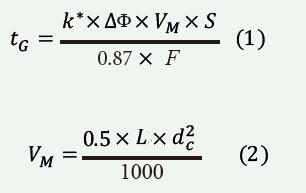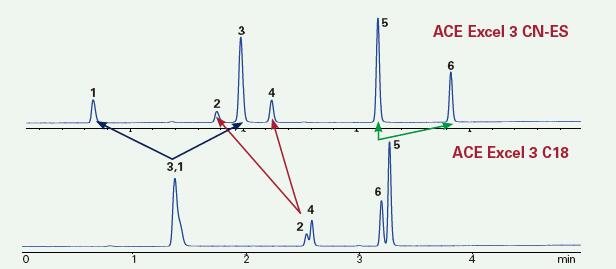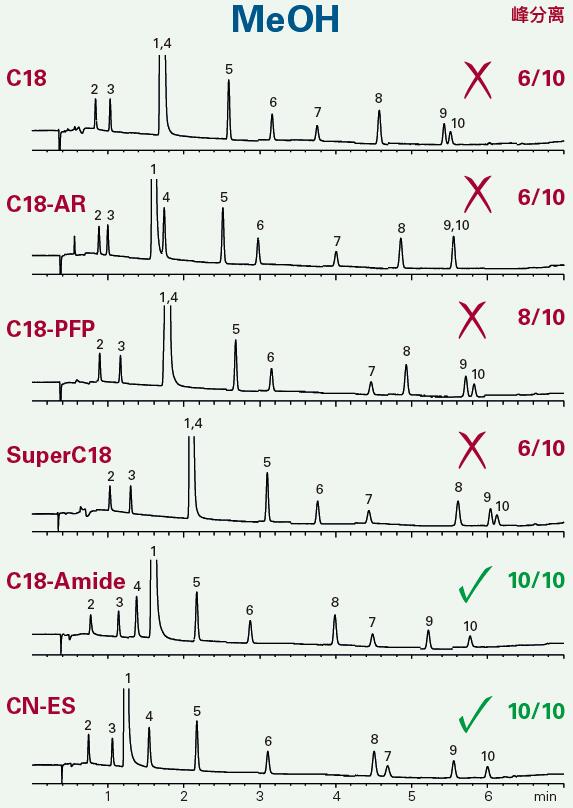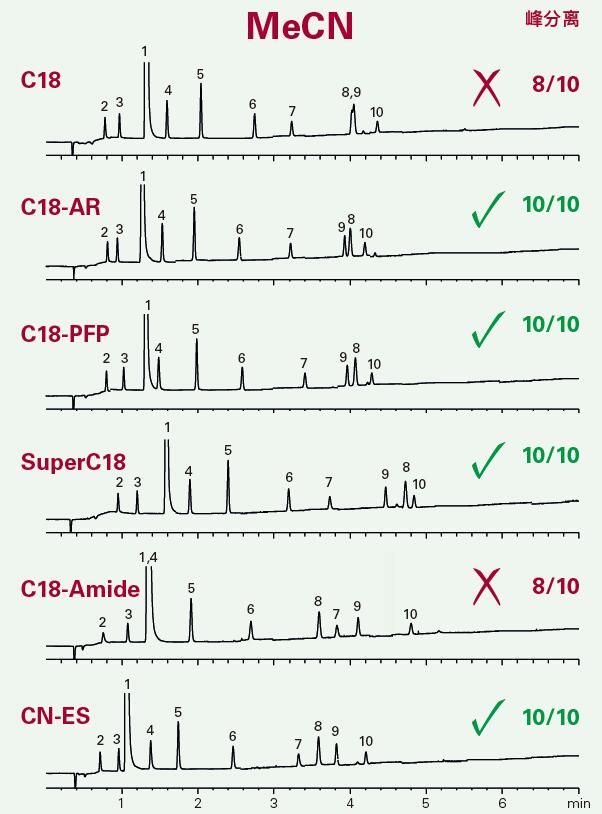Four Simplified Steps in Method Development • ACE MDKs include three columns designed for complementary selectivity.
• Column screening is a simple yet powerful way to quickly identify the most appropriate column.
• The method can be more comprehensive by screening two different mobile phase organic modifiers.
• The following flowchart summarizes how to perform method development screening in 4 easy steps.
Start
Step 1: Select mobile phase pH and buffer <br> Select based on analyte properties (ie pKa, logP and logD data). For unknown analytes, an acidic mobile phase is used as a starting point.
Step 2: Use the ACE Method Pack (3 or 6 columns)
Gradient scanning was performed with 5-95% gradient screening using MeOH and MeCN as organic solvents.
Step 3: View the data
Choose the best column and organic modifier.
The fourth step: method optimization
Check temperature, pH, gradient slope, gradient range, etc., if necessary.
Is separation achieved?
Yes - method development completed
No - Change the mobile phase conditions (pH, buffer, etc.) and return to the second step to continue the experiment.
Select the column and particle size.
It is determined by the LC system and the user's preferences. For a 400 bar HPLC system, 5μm 150 x 4.6mm is a good choice.
For 600 bar optimized HPLC systems, shorter columns of 2 and 3 μm particle size (eg 100 mm) can be used. Short columns of 1.7 μm particle size (eg 50 mm) are suitable for UHPLC systems.
How to determine the appropriate screening gradient time?
The gradient time can be calculated using Equation 1.
The VM can be calculated using Equation 2.
 | t G = gradient time (mins.) k * = gradient retention factor (usually set to approximately 5) ΔΦ = gradient range (ie for 5-95% B gradient, ΔΦ = 0.9) V M = column volume (mL) S = 5 for small molecules (<1000沓) F = flow rate (mL/min) L = column length (mm) d c = column inner diameter (mm) |
It is important to remember to perform an equal rebalance at least 10 times V M (intracolumn volume) after the gradient elution before the next injection.
Why use column screening?
• Changing the stationary phase of the column can have a significant impact on selectivity (Figure 1).
• Screening different columns under the same mobile phase conditions can help you achieve the desired separation faster and at higher resolutions.

Figure 1: Effect of changing the stationary phase of the column.
Column: 50x2.1mm
Mobile phase: A = 0.1% aqueous solution of formic acid, B = methanol with 0.1% formic acid: water (9:1 v/v)
Gradient: 3-100% B in 5 minutes,
Flow rate: 0.06mL/min
Temperature: 40 ° C
Detection: UV, 254nm
Samples: 1) metronidazole, 2) benzyl alcohol, 3) hydrochlorothiazide, 4) vanillin, 5) hydroxybenzyl ester, 6) 1,2-dinitrobenzene
• ACE MDKs combine columns with different interaction mechanisms to maximize selectivity and increase the likelihood of separating challenging mixtures.
• Cost-effective, ACE MDKs are the same price as a single column!
• Two of the most popular ACE Inversion (RP) MDKs (see table below) include phases that are uniquely designed to take advantage of different retention mechanisms and maximize selectivity.
• All six phases can be used in reverse phase (RP) conditions and have the same stability as C18.

1 Approximate value - weighted by a semi-quantitative mechanism and/or determined by reference to other ACE phases using >100 characteristic analytes.
• Other ACE method packages include the HILIC analysis package, the Biomacromolecular 300Å Analysis Kit and the Solid Core (UltraCore) Analysis Package. • Microporous column sizes (inner diameters of 0.5 and 1.0 mm) are also available.
Successful example <br> Acetaminophen and related substances
| • Select the pH of the mobile phase based on the pKa and logD of the analyte. • The use of MeOH or MeCN as the starting point for the most common method development (C18) does not allow separation of all analytes. Therefore, further method development is needed. • Use 6 columns/2 mobile phase filters to instantly identify 6 options. • No further method development is required! |
| condition: |
Automatic Massage Collapsible Foot Spa Massager
Auto Massage Foldable Foot Spa Massager is a device that provides relaxing and rejuvenating foot massage. It has a collapsible design for easy storage and transport. The massager has multiple massage rollers that target specific pressure points on your feet to deliver a deep tissue massage that helps relieve tension and improve circulation. It also has a heating function that can help soothe sore muscles and promote relaxation. The massager is easy to use and can be controlled with the push of a button. It's a great way to pamper yourself after a long day on your feet or to relieve foot pain and discomfort.
Automatic Massage Collapsible Foot Spa Massager,Folding Foot Bath Machine,Foot Spa,Massager Folding Foot Spa
Huaian Mimir Electric Appliance Co., LTD , https://www.nbmimirfootspa.com

